 Important aspect has always
been underestimated Important aspect has always
been underestimated
Postcard publishers were very quick to see the
opportunities presented by the war and therefore
postcards were on sale within three days of the
declaration of war (4 August 1914) and were widely
available before the first troops of the British
Expeditionary Force (BEF) crossed the Channel to France
and Belgium.
Many of the early commercially produced cards were
light-hearted conversation pieces which followed the
tradition of the, at that time, very popular holiday
postcards.
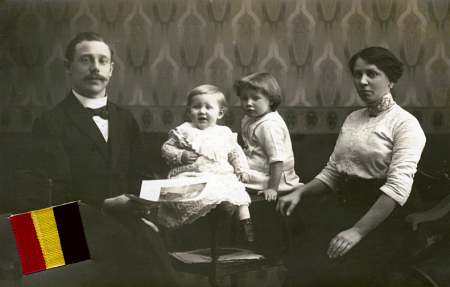 |
| Belgian family on
a
patriotic postcard |
The early British cards lampooned the Germans
in general and Kaiser Wilhelm in particular. The Germans
were always fat and mean, sausage eating cowards who
would soon run before the stout-hearted British Tommy.
But as the war became more ferocious and casualties
mounted, the tone changed. Especially after the bloody
battles in 1914 en 1915 which brought home the real
nature of the war.
The postcard producers all over the
world took the changes into account and employed some of
the best artists and card illustrators to reflect the
new topics. And with soldiers suffering the effects of
poison gas, and sometimes being blinded by it, there was
plenty of possibility for pathos.
However, very few postcards showed dead, wounded or
mutilated soldiers. Their business instincts told the
card publishers that soldiers would not want to buy such
cards and that civilians would be reluctant to remind
soldiers of their likely fate. Authorities also
discouraged publication of 'unfortunate subjects', such
as dead soldiers.
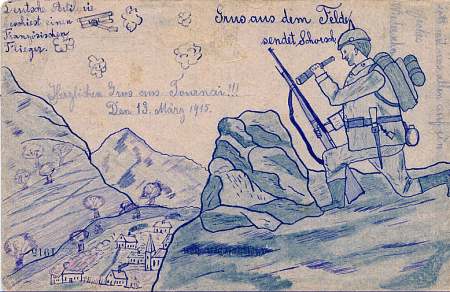 |
|
Very rare homemade German
postcard from the front in 1915 |
It was nevertheless safe for British
publishers to distribute cards showing dead Germans. And
of course, German publishers liked to show dead or
wounded British and French soldiers on their cards.
French cards often featured, in posed photographs, their
own soldiers dying on the field of honour. The French
postcard-buying public seems to have been eager on this
theme.
 Postcards illustrated the whole range of the intense
feelings
Postcards illustrated the whole range of the intense
feelings
By all belligerent nations postcards illustrated the
whole range of the intense feelings which the First
World War evoked. Also, because the drawing or
photograph on each card focused on a single theme the
effect was, and still is, a powerful one.
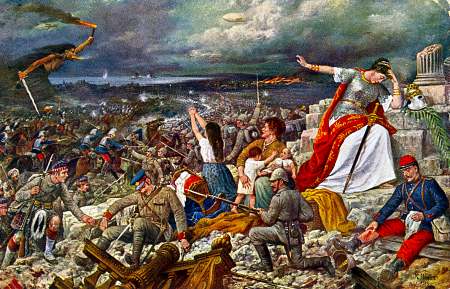 |
|
Postcard showing the horror of
war for all the people |
The main
themes are tragedy, patriotism, humour, recruits'
bewilderment with army life, the trials and tribulations
of active service, suffering and sacrifice, nationalism,
dislike and ridicule of the army, glory, romance, love
of children, trust in God, hardship and heroism.
So postcards were a reflection of the national
personality and attitudes of the principal belligerents.
French-designed postcards are vividly different from
those made for British use, while German, Russian (hard
to find), Belgian and American cards also showed their particular
distinctions.
At other times the producer of a card had propaganda in
mind, such as rousing the passions of the public against
the enemy. Many French postcards stress the unity and
purpose of the Entente Cordiale - the treaty between
France and Britain - and then of the Triple Entente,
Britain and France plus Russia.
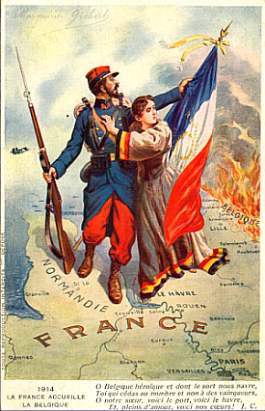 |
|
Patriotic French postcard |
The primary objective of the postcard publishers' was to
sell them at a profit, so they supplied the market with
what they believed people wanted. They frankly exploited
sentiment and sentimentality; among the best selling
cards were those which showed blinded soldiers.
Generally the producers were convinced that the soldiers
themselves wanted to present the war to the people at
home in terms of its being a rather rough and
uncomfortable game, something which aroused an ironic
laugh in the recipient. These cards never show a British
soldier wounded, dead or really suffering. Here, at
worst, life at the front was portrayed as muddy, noisy
and tiring.
 The Press Bureau for censorship after 15 September 1915
The Press Bureau for censorship after 15 September 1915
From 15 September 1916 all new pictorial representations,
including picture postcards and cigarette stiffeners,
and other illustrated subjects of a military nature had
to be submitted to the Press Bureau for censorship
before publication.
On that day the first action by British tanks began; it
was the start of the final stages of the Somme offensive.
The Army feared that enthusiastic postcard producers
might give away secrets about the tanks, the great
innovative weapon of the war.
But the artists had never
seen a tank and had only their imagination to draw upon;
they made them look even more fearsome than they really
were!
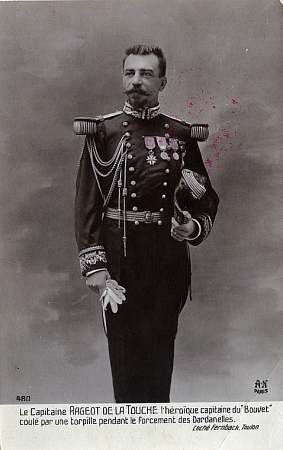 |
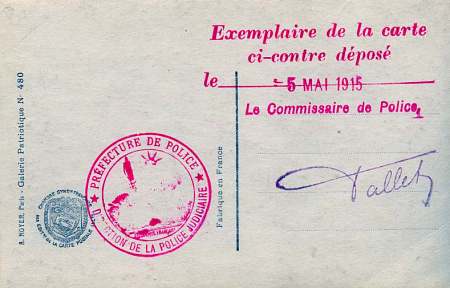 |
The French
Press Bureau giving permission by the chief of
police to publish the postcard
with the portrait of captain Rageot de la
Touche, captain of Le Bouvet - one of the French
ships of war sunk during the sea battle in the
Dardanelles (The Straits) |
It is maybe a fair generalisation to say that British
war cards understated whatever they depicted, and that
French ones would overstate it, often to the point of
absurdity. German postcard designs were stoical and
nationalist in mood. American cards - the United States
entered the war in April 1917 - were, in effect,
statements of 'Stand aside, buddy, the Americans are
here now'.
A good many cards had both French and English text, not
only to appeal to a potentially bigger market but to
make the card seem more exotic and therefore more
desirable. A few cards had text printed in English,
French and Flemish, the latter included to flatter the
many Flemish-speaking Belgians. Other English language
cards also used Russian.
 Postcards were enormously popular and cheap
Postcards were enormously popular and cheap
Postcards were enormously popular at the time. Many
British soldiers hated having to write letters and found
to their satisfaction that a card required a minimum of
effort while indicating the maximum of thoughtfulness.
Sometimes they wrote no more than five or six words on a
card. French soldiers, on the other hand, were
different. Writing in small, fine script, they could
cram a remarkable amount of information onto a card.
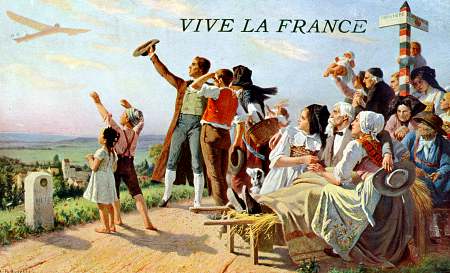 |
Friends and family at home often used cards rather than
letters as they were generally brightly coloured and
because they believed, often quite wrongly, that men at
the front did not want to be 'bothered' by the everyday
details of domestic life.
For both the soldier and his family a postcard was safer
than a letter because no real depth of feeling or
sentiment was necessary. Of course, people did possess
very real depths but they were reluctant, even afraid,
to express what lay in those depths.
Neither group, soldiers nor civilians, wanted to 'upset'
the other. What mattered was to receive a card with a
well known or dearly beloved name on it. It was up to
the recipient to decode the brief written message and
read what lay behind it.
By now many postcards of 1914-1918 may seem naive,
grossly over-sentimental, sometimes distasteful and
extravagant in the message of their design. Some can be
criticised on a purely military basis, since uniforms
and equipment are often inaccurately depicted.
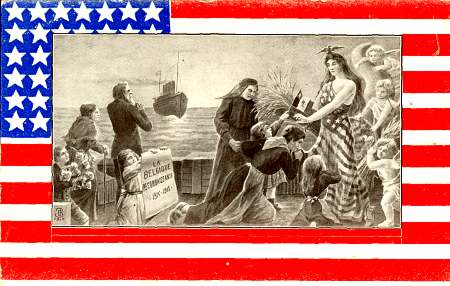 |
Captions
are often even more inaccurate. But few people of the
time would have been critical of these errors. For them,
the cards depicted fundamental realities. They were more
interested in impressions than in facts.
Throughout the war postcards were cheap, at a halfpenny
or penny each, together with halfpenny postage within
Britain and one penny overseas. Soldiers paid only a
halfpenny postage wherever they were. Their mail was
collected by the battalions and despatched across the
Channel for posting in Britain.
Postcards, when sent by
the soldiers from the battle areas to their homes, were
subject to the same rules of censorship as were letters.
When they were posted within the unit they were read by
company officers, but it is extremely rare to find
anything blacked out on a wartime card.
 Postcards are historically valuable war documents
Postcards are historically valuable war documents
Postcards are historically valuable war documents
because they cover a wider field than photographs. No
photographs were ever taken of much of that which was
illustrated by artists.
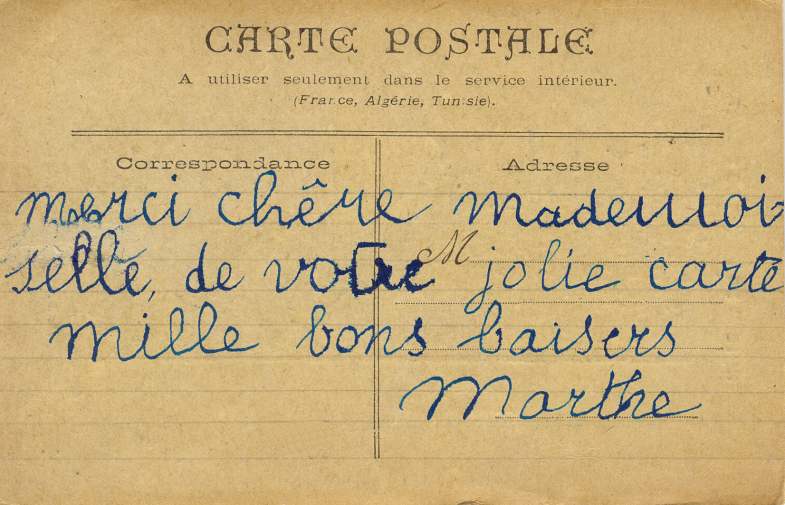 |
Original Thank you postcard from
the front for sending a nice postcard to a
soldier.
Translation: Thank you dear miss for your nice
postcard
A thousand dear kisses
Marthe |
In postcards is frozen all the
sentimentality and the seriousness of a four-year war
period. And not at least, war postcards are greatly
entertaining and informative. They have brought some
humanity and colour to a dark, inhuman activity and have
left us a unique link with people of that time.
 No picture postcards in the Second world War
No picture postcards in the Second world War
During the Second World War the perception of war was of
a completely different nature than during the First
World War. Without a doubt this new perception was based
on the terrible experiences in the First World War which
only became entirely clear in the years after the First
World War and in the dark times of the economic
depression in the Interbellum.
Also the war situation was of a completely other nature:
for almost five years there were no fronts in Europe
where hundred thousands of men would have to maintain
contact with the home front.
There was simply no longer
need for the type of picture war postcards which were so
characteristic for the First World War.
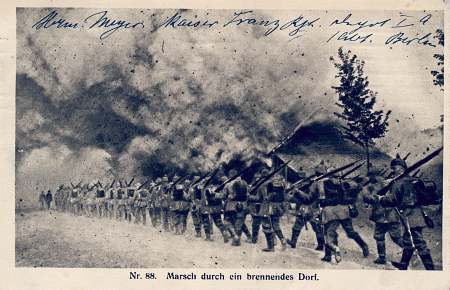 |
|
German postcard showing troops
passing a burning village. |
When the Armistice was signed on 11 November 1918 the
event was celebrated with a flurry of colourful,
extravagant cards. The Armistice signified not only the
end of hostilities of the First world War, but also
brought to a close the era of the war picture postcards. |